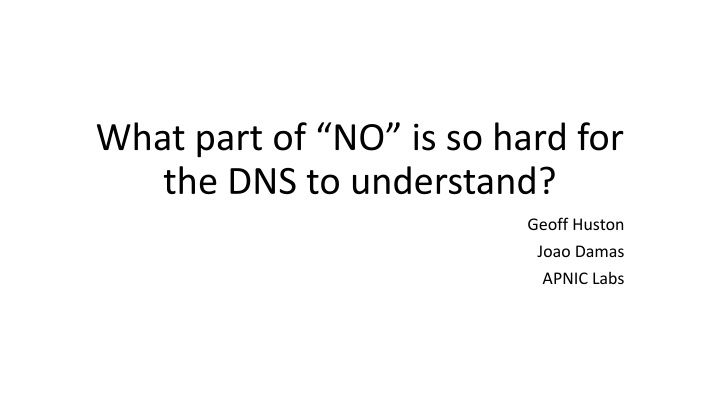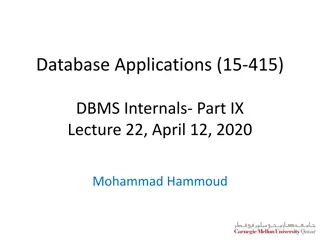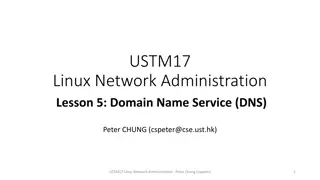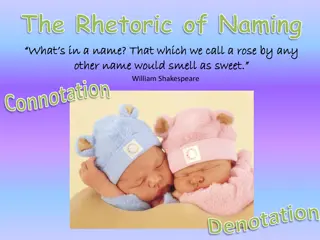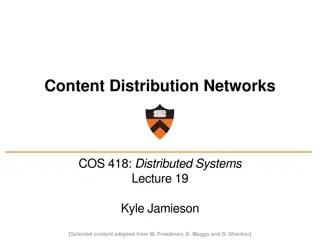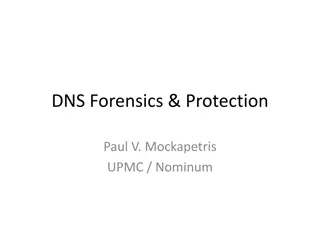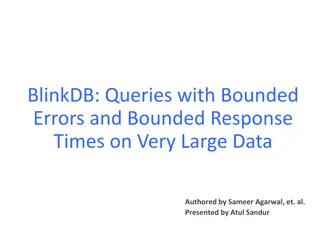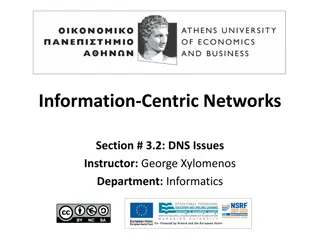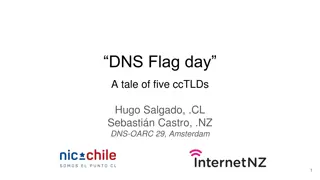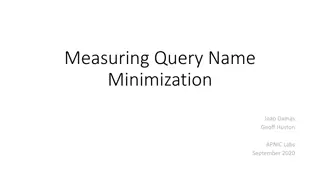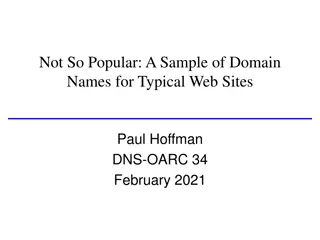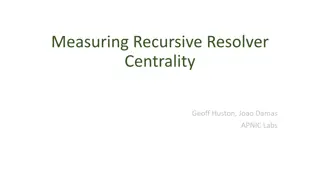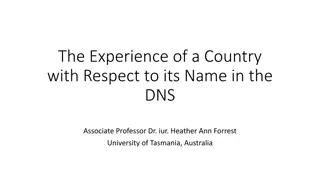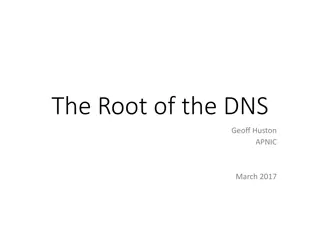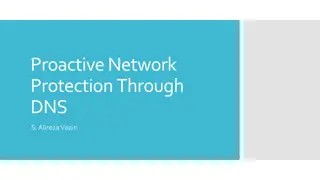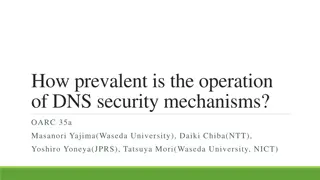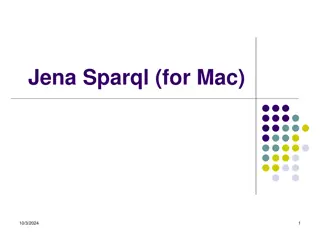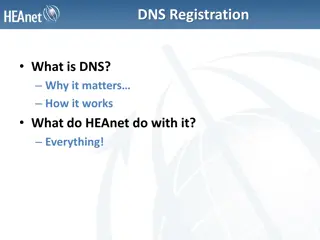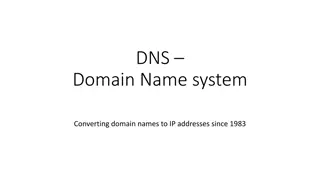DNS Query Behavior Analysis: Understanding Queries for Non-Existent Names
Exploring the unexpected high number of DNS queries for non-existent names and the factors contributing to this behavior, including Happy Eyeballs and client query patterns. Revealing insights into the complexities of DNS resolution processes.
Download Presentation

Please find below an Image/Link to download the presentation.
The content on the website is provided AS IS for your information and personal use only. It may not be sold, licensed, or shared on other websites without obtaining consent from the author.If you encounter any issues during the download, it is possible that the publisher has removed the file from their server.
You are allowed to download the files provided on this website for personal or commercial use, subject to the condition that they are used lawfully. All files are the property of their respective owners.
The content on the website is provided AS IS for your information and personal use only. It may not be sold, licensed, or shared on other websites without obtaining consent from the author.
E N D
Presentation Transcript
What part of NO is so hard for the DNS to understand? Geoff Huston Joao Damas APNIC Labs
We were looking elsewhere We were setting up a measurement experiment that was looking at the extent of support for aggressive NSEC caching (RFC8198) in the DNS The experiment setup involved presenting to the user a DNS name that did not exist from a signed zone, so that we would pass an NSEC record to a DNSSEC-aware resolver But was was intriguing was that we were seeing many more queries for the non-existent name than we had expected
What we saw: We used an online ad to get users to query for a unique non-existent DNS name And then counted the number of queries we saw for these names Names Repeat Queries 42% Queried Names: 60,210,983 DNS Queries: 142,631,272 58% That s an average of 2.37 queries per non-existent name! Why so many queries?
Expectations If NO means NO then na vely we would expect to see 1 query per name, not 2.37 queries per name But maybe that s just too na ve these days
Happy Eyeballs and the DNS A happy eyeballs dual stack client will launch 2 DNS queries back-to- back (roughly), for A and AAAA records of the name 23% of clients asked both A and AAAA records 3% asked only AAAA records (*) 74% asked only for A records AAAA? A? * If the client asks for a AAAA record and waits for a response before asking for the A record then the NXDOMAIN response will stop the connection process and any subsequent A query will not be performed
Factoring Happy Eyeballs If we split out the A and AAAA queries the experiment launched 73,537,852 DNS resolution events We saw 142,631,272 DNS queries, or an average of 1.93 queries per name Names Happy Eyeballs Repeat Queries That s better, but still unexpectedly high 42% 48% 10%
Single vs Multiple Queries 36,059,484 resolution events were completed with just 1 query to the authoritative server (49% of all resolution events) If there were multiple queries for a name (>= 2 queries(, then the average of the multiple queries was 2.84 queries
Distribution of Queries Is this a generic issue of re-queries across a large set of queries? Or a small number of queries that are the subject of a frenzy of re- queries?
Re-query Distribution 32% of queries were parts of query sequences of 3 or more
Does UDP suck THAT much? Why is the total re-query rate at 51% of tests? Surely DNS over UDP is not THAT bad The servers are responding to every query The signed response is 603 bytes in size We are using a distributed setup of servers to localize DNS transactions So why are the servers seeing 51% of tests generate 2 or more queries?
Re-Query Time Intervals There are strong local peaks at regular 1 second intervals this would appear to be an end host re-query behaviour
Re-Query Time Intervals There are local re-query peaks here at 370 ms, 800ms, 1 sec and 1.5sec It is likely that these time intervals represent recursive resolver re-query timers 370ms 800ms 1s 1.5s
Re-Query Time Intervals One half of all re-queries occur in the first 250 ms
DNSSEC? This is a DNSSEC-signed non-existent name. Is DNSSEC a factor in the excessive re-query volume? i.e. is the additional time to validate causing requery timers to trigger? We added an unsigned non-existent name to the test set
Signed vs Unsigned Signed Unsigned Experiments A/AAAA Queries 65,686,452 81,057,694 153,697,947 69,251,349 84,979,990 122,665,888 Split out the happy eyeballs factor Single Query Exps 47,694,930 Ratio 60,061,746 71% 59% Multi-Query Exps 33,092,764 Re-Query Rate 24,918,244 2.51 3.19 DNSSEC validation adds delay, and in around 12% of cases this additional delay causes the resolver system to re-query the name
Signed vs Unsigned So there are a set of resolvers that are working on the margins of their timers, and in 12% of cases the additional DNSSEC queries to perform validation cause the resolver to time out and re-query. OK but the 12% delay factor is still not enough to explain the high query rate for NXDOMAIN responses What else is going on?
NXDOMAIN re-queries 39% of queries are re-queries when the domain is signed And of those, 30% are the same source address and 69% are the same subnet 29% of queries are re-queries when the domain is unsigned And of those, 11% are the same source address and 50% are the same subnet It appears that DNSSEC validation adds a time component that causes resolvers to trigger internal timers and re-query in around 12% of cases
Re-Queries per resolver IP addresss The log scale exaggerates the effect, but we observe that a DNSSEC-signed NXDOMAIN response generates a higher repeat query profile from the same resolver IP address
Resolver farms We also see query patterns of the form: Resolver 7x.xxx.0.178 6z.zzz.161.146 7x.xxx.0.230 6z.zzz.161.220 7x.xxx.0.188 6z.zzz.161.182 7x.xxx.0.180 6z.zzz.161.144 7x.xxx.0.226 7x.xxx.0.138 6z.zzz.161.134 6z.zzz.161.222 Query Time 0.752 0.865 0.980 1.094 1.201 1.319 1.430 1.542 1.650 1.654 1.762 1.775 It appears that some resolver farms operate by farming the query across all members of the farm. This pattern seen here shows two such cases where different IP addresses in the same subnet repeat the initial query at approximately 100ms intervals How common is this form of subnet-based query repetition?
Re-query Profile Signed 153,697,947 59,782,873 Unsigned 122,665,888 35,297,618 4,024,583 17,618,192 Queries Re-queries Same IP Address 17,848,729 Same Subnet 41,111,416 Some 70% of the re-queries are from resolvers that share the same subnet prefix when the domain is DNSSEC signed. This drops to 50% with an unsigned domain This points to some outstanding issues with resolver farm management
It may sound odd but Is NXDOMAIN part of the issue here? Is the re-query rate lower if the name exists in the DNS? So we also ran the same query count for queries to a dual-stack defined domain name that did exist in the DNS
NXDOMAIN vs A/AAAA re-queries NXDOMAIN Signed: A/AAAA Signed: 41% of experiments generate multiple queries 39% of queries are re-queries (avg of 3.19 queries per experiment) 18% of experiments generate multiple queries 13% of queries are re-queries (avg of 5.81 queries per experiment) NXDOMAIN Unsigned: 39% of experiments generate multiple queries 29% of queries are re-queries (avg of 2.51 queries per experiment) A/AAAA Unsigned 38% of experiments generate multiple queries 36% of queries are re-queries (avg of 3.03 queries per experiment)
NXDOMAIN vs A/AAAA re-queries NXDOMAIN Signed: A/AAAA Signed: 41% of experiments generate multiple queries 39% of queries are re-queries (avg of 3.19 queries per experiment) 18% of experiments generate multiple queries 13% of queries are re-queries (avg of 5.81 queries per experiment) NXDOMAIN Unsigned: 39% of experiments generate multiple queries 29% of queries are re-queries (avg of 2.51 queries per experiment) A/AAAA Unsigned 38% of experiments generate multiple queries 36% of queries are re-queries (avg of 3.03 queries per experiment)
How Odd! The proportion of experiments that are completed in a single query are unchanged with there is an unsigned response Where re-query occurs the average number of queries per experiment rises from 2.5 to 3.0 The proportion of experiments that are completed in a single query rise with there is a signed response Where re-query occurs the average number of queries per experiment rises from 3.2 to 5.8
WTF? A DNSSEC-signed NXDOMAIN response generates more re-queries than a DNSSEC-signed A / AAAA response
Pulling it back together Why are there so many repeat queries? <reasons> Resolver Farms NXDOMAIN DNSSEC Signing Happy Eyeballs Names Happy Eyeballs DNSSEC NXDOMAIN Farmed Load Other 4% 13% 42% 14% 17% 10%
